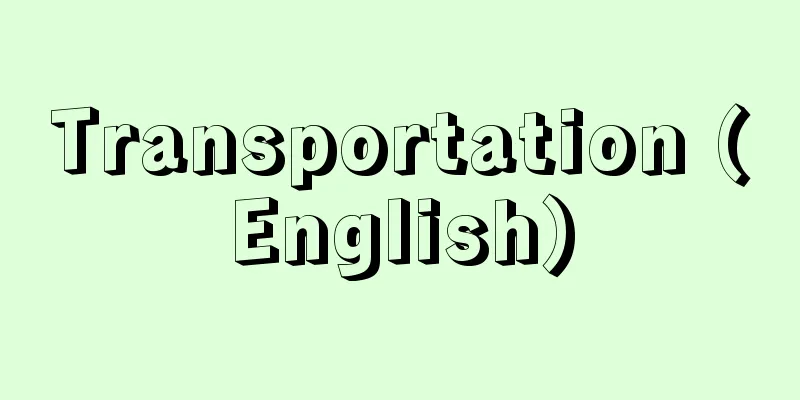Transportation (English)

|
The movement of people or things from one point to another. Although there are slight differences in nuance depending on the word, it can also be expressed as transportation, shipping, or carriage. It can be said that transportation has existed alongside the progress of mankind. The world has undergone great transformations with the horse-driven travel of nomadic tribes, the use of sailing ships during the Age of Discovery, the invention of the steam locomotive during the Industrial Revolution, and the widespread use of automobiles. In today's age of globalization, the importance of transportation is increasing. It is no exaggeration to say that transportation determines the outcome of international competition. Transportation is a means to overcome time and distance, and there is usually a provider (supply) and a user (demand). The provider of transportation services receives payment (fare) from the user and provides transportation services (except for walking and cycling). In that sense, transportation appears to be a normal commodity, but its nature is quite different from that of normal commodities. First, transportation services are rarely demanded as an end in themselves, but are often demanded as a means to some other end (for example, working at a company or visiting a tourist spot). This demand is called derived demand and depends heavily on the trends of the intended demand (original demand). Second, the production and consumption of transportation services coincide in time and place. Therefore, inventory adjustments cannot be made. For example, it is not possible to run many trains during the quiet hours of the night and provide them during the morning rush hour. This characteristic causes congestion in transportation. Third, transportation services can be self-sufficient. This is the case with the use of private cars. However, self-sufficiency in transportation services is not possible for everyone. The decline of public transportation due to the spread of private cars has created transportation-vulnerable people who cannot drive private cars. Fourth, with the exception of some transportation modes, the provision of transportation services such as rail, road, and aviation requires huge investments. In some cases, the more the scale is expanded, the lower the production cost per unit can be, and in such cases, there may be fierce competition to expand scale and fare competition. Fierce competition can result in monopolies, and when the scale of investment is enormous, private operators may be unable to provide services due to fear of risk. As transportation services have characteristics that are different from normal products, they are generally subject to public intervention by the government or local governments. Typical examples include permits and licenses for fares and the development of large-scale transportation infrastructure on behalf of the private sector (airport construction and road construction). Another characteristic is that there are many safety regulations, since traffic accidents directly affect human lives. For this reason, the nature of public intervention in transportation services is constantly under discussion. [Kenzo Takeuchi] Ethnic groups and transportationTransportation, which moves people, goods, and information spatially, was born and developed with the emergence of humankind. Transportation is essential to humans and society, and the current distribution of ethnic groups on the planet can be seen as a result of human transportation. When hunting and gathering was the main form of human life, people lived a nomadic life on foot in search of food and water. They relied entirely on wild plants and animals for food, and food preservation techniques were underdeveloped, so when food in a certain area was depleted, they had to move their place of residence repeatedly. Their lives were mostly self-sufficient, and transportation was almost unnecessary for exchanging goods with other groups. As the agricultural and pastoral era came and people began to settle, the ties between regions and living communities became stronger, and eventually a clear form of political power was established and the concept of territory was born. At the same time, as the population increased, opportunities for contact with other societies and ethnic groups increased. In this process, transportation, which adjusts spatial expansion, becomes important. First, from an economic perspective, trade began from the traditional self-sufficient society, and transportation developed as the degree of dependence on others increased. Although there are cases where contact is kept to a minimum, such as silent trade, when a city is formed where goods from various regions are collected and dispersed, a trade route is created to connect them. The most notable example is the Silk Road that connected Europe and China. Politically, transportation is closely related to the penetration of political power. Ethnic groups with excellent transportation technology often gained political advantages. The construction of the vast Mongol Empire by Genghis Khan, a nomadic Mongolian tribe, shows the power of their horse-riding transportation. A similar example can be seen in Germany. Germany was a weak country that could be attacked by any of the surrounding countries due to the difficulty of concentrating military forces, but due in part to the development of its railway network, it transformed into a strong country that could attack any country. In any era, when a society seeks political integration, a transportation network is developed to ensure that central power reaches every corner and to transport tributes and other goods. In the ancient Roman Empire, roads connected the center and the periphery, and even had a symbolic meaning, so much so that it was said that "all roads lead to Rome." The Inca Empire is also famous for its elaborate road network and courier system. Transportation is not only expanded but also restricted. When people became aware of the boundaries between their own ethnic group and other ethnic groups, they used natural terrain, blocked traffic with artificial means such as castle walls, or restricted passage by imposing taxes. For example, the Han Chinese built the Great Wall to prevent the invasion of northern nomads, and in Japan, in the Edo period, the shogunate prohibited the building of bridges over major rivers and restricted the construction of large ships in order to maintain its power. Now, transportation has made great strides, going from the transportation revolution brought about by the invention of the steam engine in the 18th and 19th centuries and the development of division of labor in industry, to the use of electricity and oil today. However, despite such technological developments, various ethnic groups still use various means depending on their cultural and ecological conditions. First, the basic form of land transportation is walking. Even today, Australian aboriginals and the San people of Africa still travel on foot. They also often use animals such as dogs, cows, horses, donkeys, llamas, reindeers, camels, and elephants to travel and carry luggage. Horses are highly maneuverable and were an important means of transportation around the world, including the Hyksos' invasion of Egypt. The invention of the car and the use of animal power as its driving force dramatically increased its effectiveness, and in Europe, horse-drawn carriages were the main form of land transportation until the appearance of railways in the 19th century. On the other hand, water transportation has been popular on coasts, inland seas, and rivers since before the Age of Discovery in the 15th century. In the beginning, logs were used to take advantage of buoyancy, and leather bags, which are still used in Afghanistan today, were used, but eventually dugout canoes, reed boats, rafts, and structural ships were developed. Propulsion also changed from oars to wind power, and some tribes, such as sea nomads, made their homes on boats. [Taeko Udagawa] "Development of Transportation Economics by Eto Takuya (2003, Chikura Shobo)" ▽ "Economics of Transportation Markets and Social Capital, edited by Sugiyama Takehiko, and edited by Takeuchi Kenzo, Nemoto Toshinori, and Yamauchi Hirotaka (2010, Yuhikaku)" ▽ "Why does the taxi meter rise even when the taxi is not moving? Understanding the mysteries of transportation through economics, by Takeuchi Kenzo (2013, NTT Publishing)" [Reference] | | | | |Source: Shogakukan Encyclopedia Nipponica About Encyclopedia Nipponica Information | Legend |
|
人あるいは物が、ある地点から別の地点まで移動すること。ことばによって多少のニュアンスの違いはあるが、運輸、輸送、運送ということばで表現されることもある。 交通は人類の進歩とともにあったといえる。遊牧民族の馬による移動、大航海時代における帆船の利用、産業革命による蒸気機関車の発明、自動車の普及などによって、世界は大きく変貌(へんぼう)を遂げてきた。グローバル化の時代を迎えた現代においては、交通の重要性はますます高まっている。国際競争の死命を制するのは交通であるといっても過言ではない。 交通は時間と距離を克服するために役だつ手段であり、通常はそれを提供する(供給)側とそれを利用する(需要)側が存在する。交通サービスを提供する側が利用する側から対価(運賃)を受け取り、交通サービスを提供する(徒歩や自転車を除く)。その意味において、交通は通常の商品と同じようにみえるが、その性質は通常の商品とはかなり異なっている。 第一に、交通サービスはそれ自体を目的として需要されることが少なく、なんらかの他の目的(たとえば会社で働くことや、観光地で遊ぶこと)の手段として需要されることが多い。こうした需要は派生需要とよばれ、目的とする需要(本源的需要)の動向に大きく依存する。第二に、交通サービスの生産と消費は、時間的にも場所的にも一致する。そのため在庫調整をすることができない。たとえば夜間の空いている時間帯に列車をたくさん走らせておいて、朝のラッシュ時間帯にそれらを提供することはできない。この性質は交通において混雑が生じる原因となっている。第三に、交通サービスは自給することが可能である。自家用車の利用がこれにあたる。しかし、交通サービスの自給はすべての人に可能であるわけではない。自家用車の普及による公共交通の衰退は、自家用車を運転できない交通弱者を生み出している。第四に、一部の交通機関を除いて、鉄道や道路、航空などの交通サービスの提供には莫大(ばくだい)な投資が必要である。規模を拡大すればするほど単位当り生産コストを低下させることができる場合があり、その場合には激しい規模拡大競争と運賃競争が行われることがある。激しい競争の結果、独占が生じることがあるし、そもそも投資規模が莫大な場合には、リスクを怖れて民間事業者がサービスを提供できないことがある。 このように、交通サービスには通常の商品とは違う性質があるために、一般的に交通サービスに対しては、政府や自治体による公的介入が行われることが多い。運賃に関する許認可、民間にかわっての大規模な交通社会資本の整備(空港建設や道路建設)などがその代表的なものである。また交通に関する事故は人命に直結するため、安全に関する規制が多いのも特徴である。そのため、つねに交通サービスへの公的介入のあり方が議論されている。 [竹内健蔵] 諸民族と交通人、物、情報を空間的に移動させる交通は、人類の出現とともに生まれ発展していった。交通は人間と社会に不可欠なものであって、現在みられる地球上の諸民族の分布も人類の交通の結果とみることができる。人類にとって狩猟採集がおもな生業形態であった時代には、人々は食糧や水などを求めて徒歩で放浪生活をしていた。彼らは野生の動植物に食糧を全面的に依存し、食糧保存技術も未発達だったことから、一定地域の食糧を取り尽くすと必然的に居住地の移動を繰り返さなければならなかった。彼らの生活はほとんどが自給自足で、他集団との物資の交換のための交通はほとんど必要がなかった。やがて農耕牧畜時代になり定住化が進むと、地域と生活共同体との結び付きが強くなり、やがて明確な形の政治権力の確立と領土の概念が生まれ、同時に人口増加に伴って他社会・他民族との接触の機会が多くなる。この過程で空間的広がりを調整する交通が重要な意味をもってくる。まず経済的側面からみると、従来の自給自足的社会から交易が始まり、他に依存する程度が高くなるにつれて交通が発達する。沈黙交易のように接触が最少限にとどめられている場合もあるが、さまざまな地域の物資が集積・拡散する市(いち)が形成されると、その間を結ぶ交易路が生まれる。そのもっとも顕著な例としてはヨーロッパと中国を結んだシルク・ロード(絹の道)をあげることができる。また政治的には、交通は政治権力の浸透と密接な関係がある。交通技術の優れた民族は、しばしば政治的にも優位にたった。モンゴルの遊牧民族であったチンギス・ハンによる広大なモンゴル帝国の建設は、彼らの騎馬交通の威力を示している。同様の例はドイツにもみられる。兵力の集中の困難さから周辺のどの国からも攻められうる弱国であったドイツが、鉄道網の充実を一つの原因として、どの国をも攻撃しうる強国に変貌(へんぼう)したのである。いつの時代でも、ある社会に政治的統合が図られると、中央権力が隅々まで行き渡るように、また貢納品などの運搬のため交通網の整備が行われる。古代ローマ帝国において道は中央と周辺を結び、「すべての道はローマに通ずる」といわれるほどに象徴的意味合いさえもっていた。またインカ帝国の緻密(ちみつ)な街道網と飛脚制度も有名である。交通は拡張されるだけでなく規制される場合もある。自民族と他民族との境界が意識されるようになると、自然的地形を利用したり、城壁などの人為的手段で交通を遮断したり、税を課して通行を制限する。たとえば、漢民族は北方遊牧民の侵入を阻むために万里の長城を築いたし、日本でも江戸時代に幕府の権力保持を目的として主要河川に橋を架けるのを禁止し、大船の築造を制限した。さて、交通手段は、18世紀から19世紀にかけての蒸気機関の発明による交通革命と工業における分業の発達を経て、現在は電気や石油が利用され飛躍的な発展を遂げた。しかしこのような技術的発展をよそに依然として文化的・生態的条件によって多様な手段が諸民族によって利用されている。まず、陸上交通についてはその基本的形態は徒歩である。オーストラリア先住民やアフリカのサン人は現在でも徒歩で移動生活を行っている。さらに犬、牛、馬、ロバ、ラマ、トナカイ、ラクダ、象などの動物を移動や荷物の運搬に利用することも盛んにみられる。馬は機動性に優れ、古くはヒクソスのエジプト侵入に使われるなど、世界各地で重要な交通手段とされた。また、車の発明と畜力をその原動力とすることにより効力が激増し、ヨーロッパでは馬車が19世紀の鉄道の出現まで陸上交通の主力となっていた。一方、水上交通は、15世紀の大航海時代以前から沿岸、内海、河川において盛んに行われている。原初的には浮力を利用した丸太や、現在でもアフガニスタンで利用される皮袋が使われたが、やがて丸木舟、葦(あし)舟、筏(いかだ)舟、そして構造船がつくられる。推進力も櫓櫂(ろかい)から風力を利用するようになり、なかには漂海民のように船を住居とする民族も現れた。 [宇田川妙子] 『衛藤卓也著『交通経済論の展開』(2003・千倉書房)』▽『杉山武彦監修、竹内健蔵・根本敏則・山内弘隆編『交通市場と社会資本の経済学』(2010・有斐閣)』▽『竹内健蔵著『なぜタクシーは動かなくてもメーターが上がるのか――経済学でわかる交通の謎』(2013・NTT出版)』 [参照項目] | | | | |出典 小学館 日本大百科全書(ニッポニカ)日本大百科全書(ニッポニカ)について 情報 | 凡例 |
<<: Basic Law on Traffic Safety Measures
Recommend
Umitanago (sea bream) - surfperch
A marine fish belonging to the family Umitanidae ...
Gundeshapur (English spelling)
A city from the Sassanid Persian period in Khuzest...
Imazu - Imazu
This is the former town area in the north-central ...
Yalawach (English spelling)
?-1255? A financial official in the early Mongol E...
Konomachi butterfly (tree butterfly) - Konomachi butterfly
A general term for insects belonging to the Melani...
Karako - Karako
…The lace decoration was concentrated on the larg...
Palmier
...Add the flour and mix lightly, then transfer t...
absolutism
…In European countries from the 16th to the 18th ...
Phellodendron bark (Oubark) - Oubaku
…A deciduous tree of the Rutaceae family with bri...
Otaiko pattern - Otaikogara
...The trend started in the Kansai region and spr...
Yo - Yo
〘noun〙① Under the ritsuryo system, an item paid to...
Adour (river)
A river in southwestern France. It is 336 km long....
Amaobunegai - Amaobunegai
A gastropod shell of the family Neritidae in the ...
Zähring (English spelling)
...The highest point is the Feldberg in the South...
Tenjinzai and Kunitsuzumi - Amatsutsumi and Kunitsuzumi
A general term for crimes and disasters that were ...



![Chikugo River [Hot Springs] - Chikugogawa](/upload/images/67cc2cefb0e55.webp)





